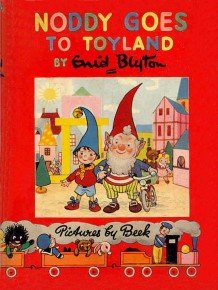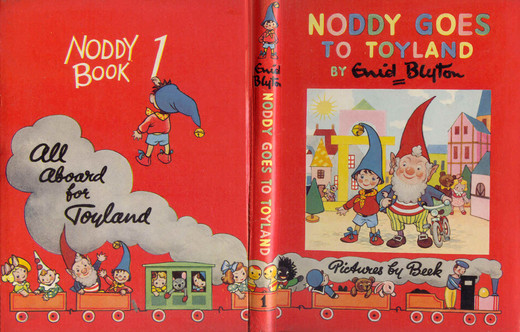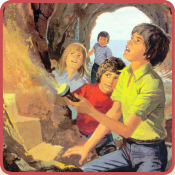
Noddy Goes to Toyland

Book Details...
First edition: 1949
Publisher: Sampson Low
Illustrator: Harmsen Van der Beek
Category: Noddy
Genre: Fantasy
Type: Novels/Novelettes
Publisher: Sampson Low
Illustrator: Harmsen Van der Beek
Category: Noddy
Genre: Fantasy
Type: Novels/Novelettes
On This Page...
Reprints
1. 1986 Macdonald Purnell, illustrations and cover by Edgar Hodges
2. 2008 HarperCollins, illustrations and cover by Harmsen Van der Beek
3. 2010 HarperCollins, illustrations and cover by Harmsen Van der Beek
4. 2016 Hodder, illustrations and cover by Harmsen Van der Beek
2. 2008 HarperCollins, illustrations and cover by Harmsen Van der Beek
3. 2010 HarperCollins, illustrations and cover by Harmsen Van der Beek
4. 2016 Hodder, illustrations and cover by Harmsen Van der Beek

Cover from the 1st edition, illustrated by Harmsen Van der Beek

Frontis from the 1st edition, illustrated by Harmsen Van der Beek



Front and back flaps from the dustwrapper of the 1st edition
and front flap from a later reprint

Title page from the 1st edition
If children enjoy Noddy, is that all that matters? Miss Blyton, of course, wouldn't think so. By writing ruthlessly down to children, she does not merely bore and antagonize grown-ups. Her Noddy books also fail to stretch the imagination of children, to enlarge their experience, to kindle wonder in them or awaken their delight in words. They contain nothing incomprehensible even to the dimmest child, nothing mysterious or stimulating. They never suggest new and exciting fields to conquer.
(Excerpt from 'A Parent's Lament' in Encounter Magazine — 1958)
James Baldwin's book Another Country could be necessary to counter possible effects of Enid Blyton's Noddy Books. Conceivably they (Noddy Books) could do more harm to the mind on children.
(Associate Professor of English at the hearing of the Indecent Publications Tribunal. — Post, March, 1964)
Noddy books have sold more than 11,000,000 to date.
(Books and Bookmen — May, 1969)
It's worth a look at the elements in Blyton's success, her compound of virtue and vice. She absorbed the world of children and gave it back to them. As someone said of her, "she knew just how children like a story to be." That was the ace in her pack. She fed the children from four to fourteen, on themselves. She satisfied them and left them hungry for more of the same. She gave children what they liked, though never what they wanted. She did not allow her readers to advance a fraction beyond where she held them. There is part of every child that does not want to grow up, and she catered for this part. Keen reading children will return to Blyton, when they are tired or ill.
(Reading and Righting, Leeson — c.1985)
... and of course, her 1949 creation Noddy, the most reviled but also the most popular character (over 70 million copies) in all children's fiction ...
(Daily Express, London — 1987)
... But in 1949 came a series that stirred up a hornet's nest of controversy and criticism ... A meeting was planned between him (Harmsen van Beek) and Enid and they planned a series of books with a little wooden man with a nodding head as the central character. The resulting Little Noddy Goes To Toyland (sic) was a phenomenal success. However the character of Noddy so beloved by children was criticized by some adults as being shallow, whining and with a limited vocabulary. There was even the suggestion of a suspicious relationship with the character 'Big Ears'. ... (Blah! Blah! Blah! Blah! Blah!) ... Some Public Librarians even took her books off their shelves (which only increased sales) and said that her writing did not allow a child to think for itself and discover other authors!
This England, Winter 1989 — with acknowledgment to Darrell Waters Ltd.
Publishers purge the Naughty Bits in Noddy's Toytown.
Noddy, Big Ears and all their friends from Toytown have been branded as being too naughty for the 1990s. After years of criticism the publishers are to withdraw them from next month and replace them with a new sanitized edition. Toytown's golliwogs will disappear to be replaced by gremlins and monkeys; words like Gay and Queer, used in their old-fashioned sense by Blyton, are being written out and wimpy girls, who need to be looked after by boys, will be given a tougher more self reliant image.. Out too go those cosy little scenes that depict Noddy and his best friend, Big Ears cuddling up in bed together after a cup of hot chocolate. Many of the Caucasian denizens of Toytown are being substituted with Chinese and even Eskimo dolls reflecting modern, multicultural Britain. In the forty years since Noddy made his first appearance the books have sold about 100 million copies.
(Dominion — August, 1990)
Enid Blyton Lives.
After three decades of banishment to Politically Incorrect Land, a literary persona non grata, Blyton has been rehabilitated. Blyton's public face was left mainly to the deliciously wicked television parodies of the 80s (Comic Strip!) but now Blyton rules, okay. She's back and definitely commercial. Children are asking libraries for Blyton books and after decades, the librarians are taking notice.
(Press Assn — c.August, 1997)
Most people remember today in history as the day John F. Kennedy was assassinated but few realize November 22nd is the day Noddy was 'born' 50 years ago. The small fresh-faced picture of an innocent English toy is still going strong with four million Noddy books being sold world-wide every year. Such is his fame, and that of his wise companion Big Ears, that the colour of Noddy's car, driven on unleaded these days, has become a children's Trivial Pursuit question. Noddy's red and yellow car has been seen around the world in 200 million books in forty languages since 1949, according to Enid Blyton Ltd.
(Press Assn — c.November, 1999).
Noddy is Big Time. Noddy is All-Pervading and it's time for proof of this. On a Thursday evening at 8pm I'm on stage at the village hall and I yell out to the audience:
"The Mystery of the Burnt Cottage. Noddy Goes to Toyland."
I ask them for comments and many hands go up. The second title is the one that will have stimulated the memory banks. One or two persons might remember reading an Enid Blyton book about 'Find-Outers' or something but 'Noddy' will hold the limelight.
I try it again.
"Noddy Goes to School. The Island of Adventure." Once again, as I have correctly gauged, the majority will have no trouble relating to the little nodding man.
Another attempt:
"Noddy gets into Trouble. Five on Kirrin Island Again."
Here's where I make my big mistake. I've just yelled out a title that could be considered as powerful, if not more so, than the Fabulously Famous Noddy. I have to discreetly withdraw — one cannot take the name of the Kirrins in vain. Furthermore, as it's past 8pm, every single hand would probably rise for the 'Famous Five' because all the little children will be asleep in their beds.
Noddy is still 'Very Big-Time' though and he's been going strong since 1949. Despite his ability to raise ire in people who possess a certain view and a certain upbringing if you know what I mean (I think you do), he will not go away. It's only fair and reasonable that the three or maybe four people in the world who have never heard of Noddy should learn of him and those others who are dickering as to whether they should re-read the series can have their interest aroused. Commenting on Noddy is really a matter of revealing most of the contents because they are little books with fairly benign plots designed for small children who generally don't surf around the internet reading reviews and who may get the most pleasure from viewing all the lovely colourful pictures whilst mother or father reads the story to them.
Noddy lives in Toyland but he first had to get there and then he had to go to court and prove he was a toy in order to stay there. Here's what happened:
Big-Ears (the opening words in the very first Noddy book!) is bicycling through the woods when he crashes into someone. Down he goes as does the other person and then they sit up and appraise each other. Big Ears is a fairly run-of-the-mill brownie with a tall conical red hat and a long white beard but the other figure seems to be of an unknown species. It looks like a little man with a shock of brown hair and a head that has a tendency to nod all the time. Big-Ears has a few questions to ask ... as you do when you encounter a naked man strolling through the forest. He asks him why his head nods and the little man tells him it's the way the thing is balanced — he has to nod when he speaks.
"Where do you live?"
"I belonged to Old Man Carver away in the woods. He made me." It's quite inspiring to learn a few facts about this remarkable little character who has swept the continents of the world.
"You've got funny eyes — and funny hair too."
"The old man made holes in my wooden head and then pushed blue beads into the holes" says the nodding man. "He made my hair out of bits of fur from his cat's back."
"Why have you run away?"
"Because it's so lonely with Old Man Carver ... and he's carving a lion now. I don't like lions ... I want to live with lots of people."
The story then follows on with Big-Ears stating that as the little wooden man is not a brownie he can't live with him in his own town so he offers a lift on his bike to the station in order that he can catch a train to Toyland. Along the way he enquires as to the little man's name and it turns out that he doesn't have one. It's here that a very historic moment takes place — Big-Ears christens him with a very appropriate name — 'Noddy' and then decides to accompany him to Toyland. A little train features on the covers of the Noddy books and a similar one takes him and his new found friend off on their journey. There are plenty of passengers amongst of which are a rabbit, dolls, a pink cat, several golliwogs and even some clockwork mice who are bound for Clockwork-Mouse-Town.
Noddy reaches Toyland and he alights with Big-Ears at Toy Village — ready to begin the life which has affected teachers, librarians, professors, and many others of that ilk who have taken it upon themselves to dictate as to what children should and should not read.
Big-Ears is growing fond of the funny little nodding man and is prepared to help him settle into his new environment. The first thing to do of course is to fit him out with some clothing so it's off to the market where there are plenty of well-stocked stalls. The first item of clothing that the wooden man acquires is a pair of red shoes. Then it's blue trousers — wide at the bottom, and after that it's a red shirt a yellow belt and a yellow tie (with red polka-dots) to match. Noddy now looks the way he's going to look for the rest of his life excepting for one very important item. They search out a hat stall. Big-Ears is lending Noddy money to pay for everything but Noddy is a very innocent little person. He doesn't know what money is or how to get it and when he's trying on hats he thinks he'd look good in a baby-doll's bonnet. Big-Ears sorts him out and explains a few things to him.
"You can't wear a bonnet; you're not a baby doll. Really, you don't know very much, Noddy."
Big-Ears picks out a tall hat like his own but this one is blue and it has a little bell right at the top.
Noddy, the Exalted Being, in all his Glory — now Exists!
A nearby policeman is not interested in the Glory and Fabulous Famousness of Noddy. He confronts him and demands to know whether he is a real toy because if he's not he must clear out! Noddy is pretty sure he's a toy. He knows he's not a fairy. The policeman suggests that he might be an ornament — like a china pig is but as he’s never been stood on a mantelpiece and hasn't been played with by children, there are grave doubts as to Noddy's authenticity and this will have to be ruled upon — in Court!
Big-Ears is not worried. He's confident that Noddy's fides are bona. He takes him house-hunting but all the dwellings are full up so why not build one out of toy bricks? Wonderful idea. They acquire a House-for-One from a great shed which contains plenty of bricks suitable for building houses, shops and even castles. They grab a box for themselves and Big-Ears tells the soldier on guard that he'll have to send them a bill because he hasn't any money. I like that about Toyland — it has a kind of easy-going, don't-worry-about-anything atmosphere — although Noddy, admittedly, has a small anxiety which needs to be addressed. The bricks are carried to a dear little street and they begin assembling the house in a space between two others. It is great fun but you need a certain amount of expertise when erecting a home and Noddy doesn't really possess the necessary. He wants to put the roof on first so that if it rains they won't get wet! Big-Ears clues him up on that then builds a wall himself and forgets to leave a space for the window. Noddy, getting on like a house on fire, builds a wall as well but forgets to leave a space for the door — still, they're really enjoying themselves. To add the chimney they need to borrow a ladder and they do so from a bear called Mr. Tubby who lives next door. He's very obliging and helps finish the little dwelling then invites them in for a cup of tea. Noddy learns what a bath is when he sees one in the grand house that belongs to Mr. Tubby and his wife and then it's eating time and there's a cosy little picture of them all having tea and cake. Noddy is beginning to feel very, very happy but there's still that little nagging problem about his position in the natural order of things.
After tea, Noddy and Big-Ears walk through Toy Village and see the pretty houses and the dolls hanging clothes out on the line, chattering to neighbours and bringing home the shopping. They watch the soldiers drilling in the castle grounds and Noddy then spies a 'Noah's Ark'. For those who've never heard of a Noah's Ark, it's the legendary name given to an enormous, gigantic, monstrous boat that was supposed to have housed a male and female of every species of animal and bird and insect and What-Have-You on the planet when a great big flood came to drown everyone and everything. They are a popular children's toy — or they were, and naturally Toy Village has at least one of them. Noddy leaves Big-Ears and wanders over to the Noah's Ark and being an inquisitive little man he opens the door to have a peek but that's the last thing to do when you are on a Noah's Ark. Hordes of animals spill out and it's only good luck that Mr. and Mrs. Noah unexpectedly return and chase them all back ... all, that is except for one lion who wants to go away on his own for a bit. The great big creature scares a doll who screams for help and Noddy runs to her assistance. Showing considerably bravery he attacks the lion who runs back to the ark in quite a terrified state (he's really quite a kindly old lion). Noddy comforts the doll and then her mother arrives on the scene. She's very impressed with Noddy's courage and thanks him profusely.
The only thing to do now is to establish Noddy's right to reside in his little house to which he has definitely taken a liking. The pros and cons are argued in court before a judge who looks remarkably like a Beautiful Blonde. He makes his decision after Noddy receives a little unexpected help and I think the answer is known to all because Noddy and his good friend — Big Ears not to mention Mr. & Mrs. Tubby and the rest of the Toy Village inhabitants are cemented into the lives of so many who have followed their adventures from earliest childhood times.
The pictures are colourful and there are plenty of them which is what young children like. In fact, if you look at all the major Enid Blyton series and even collections of short stories the Noddys would be about the only ones drawn in colour — that doesn't include the large books of course which generally contain reprints. The artist for Noddy Goes To Toyland was a Dutch man with a rather involved name but let's call him, as stated somewhere above — Harmsen Van Der Beek.
Noddy's head is on a little spring and that should adequately explain his nodding propensities.
In the late 1990s, Guinness Publishing crowned Betty & John Hopton as the holders of the greatest collection in the world of Noddy memorabilia.
Enid Blyton created several females who wanted to be males and it’s refreshing to see the reverse happening but I’m in no doubt that the judge’s personal problem regarding his gender would not affect his judicial expertise.
Why is Noddy so reviled by so many? Anything that's 'All-Pervading' will be reviled on and off by the general populace. If you take a look at the various institutions that affect our lives it's not too difficult to pick out the ones that invite more comment — usually in the negative than in the positive. Religion is one, and so is the Government. They invade out lives and are sitting ducks for criticism. Then you have those that affect us all on a more personal basis such as the power and telephone companies. Who hasn't complained about them? Who hasn't complained about the television service? Enid Blyton is All-Pervading and she naturally attracts her share of bad feeling as does Noddy. Mind you, he could be seen as a little pathetic when he gets into a tantrum or starts bawling but he's loved by millions of younger children and the author considered those people as the most important of all the consumers.
The Noddy book originals, like many classes of Blyton books have become quite valuable provided you can work out whether the edition you have is genuine. In the Eighties you could ask about £15 for a very-good copy. Round the mid Nineties a first edition of Noddy Goes to Toyland might reasonably expect a £40 price-tag ... less without a cover of course. The early ones can be difficult to identify but there are reference facilities available and at least one of the auction sites contains relevant information — however the best source is The Enid Blyton Society — where else? The Society has the definitive bibliography available and that's sure to contain anything you wish to know about anything Blyton and there is also a magazine available by subscription that has scads of statistics on, not only Noddy books, but piles of others. Hoping that I might be able to use my reference book as the means for purchasing a new car I consulted the Enid Blyton Magazine in this case. The fifth issue contains a listing of the various Noddys and as the reference copy wasn't eligible I looked at another. No luck with that one either — but that doesn't matter at all. It's got 'Noddy Book No.1' on the back so all I need to do is to advertise it as a First Edition on an internet auction site and someone will give me £50 or more for it because that's what happens. The buyer will sell it a year or so later and get £65 so we all win. In this particular case, I won't win because I wouldn't do that!
I'm still thinking of that passage above regarding the author's books: "They never suggest new and exciting fields to conquer." This was written by a chap who really must have had a 'Down' on Enid Blyton!
It's well worthwhile having another look at Noddy if you have been out of touch for eons and it appears that at least one contributor to the Enid Blyton Society Forums is doing so. There are things that I can’t recall about Noddy although I must have been aware of them when I first read the collection many years ago but certain details would have been locked away in the subconscious mind. I had read Noddy Goes to Toyland of course so I must have known amongst other facts that Noddy was made by Old Man Carver. If I'd been asked about the first appearance of the little wooden man I'd have said that he was found in the forest — possibly by Big-Ears or maybe he just wandered into Toy Village by himself. I also couldn't remember that his hair had come from bits of fur purloined from the back of the old carver's cat (incidentally, the cat didn't mind donating it)! If I'd been asked where Noddy and Big-Ears live, I would have answered that they reside next door to each other, but looking at the strict rules regarding the acceptance of other races, ethnicities, species or however it is worded, a brownie immigrant into Toy Village might not be acceptable. I'll definitely look forward to finding out about this and a lot more concerning the Fabulously Famous Noddy.
Tony adds: Noddy actually made his debut when the first two books were serialised in the Sunday Graphic. Interestingly the second book, Hurrah for Little Noddy was the first to appear, serialised from June 5 to July 31, 1949 and this was followed by Noddy Goes to Toyland from August 7 to September 25, 1949. This was published as the first Noddy book in November of that year.







 Book 1 of 24 in this category
Book 1 of 24 in this category 